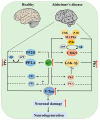Zinc in Regulating Protein Kinases and Phosphatases in Neurodegenerative Diseases
- PMID: 35740910
- PMCID: PMC9220840
- DOI: 10.3390/biom12060785
Zinc in Regulating Protein Kinases and Phosphatases in Neurodegenerative Diseases
Abstract
Zinc is essential for human growth and development. As a trace nutrient, zinc plays important roles in numerous signal transduction pathways involved in distinct physiologic or pathologic processes. Protein phosphorylation is a posttranslational modification which regulates protein activity, degradation, and interaction with other molecules. Protein kinases (PKs) and phosphatases (PPs), with their effects of adding phosphate to or removing phosphate from certain substrates, are master regulators in controlling the phosphorylation of proteins. In this review, we summarize the disturbance of zinc homeostasis and role of zinc disturbance in regulating protein kinases and protein phosphatases in neurodegenerative diseases, with the focus of that in Alzheimer's disease, providing a new perspective for understanding the mechanisms of these neurologic diseases.
Keywords: Alzheimer’s disease; neurodegenerative diseases; protein kinases; protein phosphatases; zinc.
Conflict of interest statement
The authors declare no conflict of interest.
Figures


Similar articles
-
Phosphatases in plants.Methods Mol Biol. 2015;1306:25-46. doi: 10.1007/978-1-4939-2648-0_2. Methods Mol Biol. 2015. PMID: 25930691 Review.
-
Kinases and phosphatases in the mammalian circadian clock.FEBS Lett. 2011 May 20;585(10):1393-9. doi: 10.1016/j.febslet.2011.02.038. Epub 2011 Mar 3. FEBS Lett. 2011. PMID: 21376720 Review.
-
Human Protein Kinases and Obesity.Adv Exp Med Biol. 2017;960:111-134. doi: 10.1007/978-3-319-48382-5_5. Adv Exp Med Biol. 2017. PMID: 28585197 Review.
-
Focus issue: systems analysis of protein phosphorylation.Sci Signal. 2010 Aug 31;3(137):eg6. doi: 10.1126/scisignal.3137eg6. Sci Signal. 2010. PMID: 20807952
-
Protein kinases and protein phosphatases encoded in the Ciona robusta genome.Genesis. 2022 Mar;60(3):e23471. doi: 10.1002/dvg.23471. Epub 2022 Mar 9. Genesis. 2022. PMID: 35261143
Cited by
-
The Role of Zinc in Modulating Acid-Sensing Ion Channel Function.Biomolecules. 2023 Jan 24;13(2):229. doi: 10.3390/biom13020229. Biomolecules. 2023. PMID: 36830598 Free PMC article. Review.
-
Multi-target approach to Alzheimer's disease prevention and treatment: antioxidant, anti-inflammatory, and amyloid- modulating mechanisms.Neurogenetics. 2025 Apr 1;26(1):39. doi: 10.1007/s10048-025-00821-y. Neurogenetics. 2025. PMID: 40167826 Review.
-
Brain transcriptomic signatures for mood disorders and suicide phenotypes: an anterior insula and subgenual ACC network postmortem study.Brain Behav Immun Health. 2025 Jul 5;48:101051. doi: 10.1016/j.bbih.2025.101051. eCollection 2025 Oct. Brain Behav Immun Health. 2025. PMID: 40686931 Free PMC article.
-
Brain transcriptomic signatures for mood disorders and suicide phenotypes: an anterior insula and subgenual ACC network postmortem study.bioRxiv [Preprint]. 2024 Aug 16:2024.08.14.606080. doi: 10.1101/2024.08.14.606080. bioRxiv. 2024. Update in: Brain Behav Immun Health. 2025 Jul 05;48:101051. doi: 10.1016/j.bbih.2025.101051. PMID: 39185191 Free PMC article. Updated. Preprint.
-
Homeostasis and metabolism of iron and other metal ions in neurodegenerative diseases.Signal Transduct Target Ther. 2025 Feb 3;10(1):31. doi: 10.1038/s41392-024-02071-0. Signal Transduct Target Ther. 2025. PMID: 39894843 Free PMC article. Review.
References
-
- Jackson M. Zinc in Human Biology. Springer; Berlin/Heidelberg, Germany: 1989. Physiology of zinc: General aspects; pp. 1–14.
Publication types
MeSH terms
Substances
LinkOut - more resources
Full Text Sources
Medical
Research Materials
Miscellaneous

